The environmental problem is as important as the development problem which exists in every country in the world. The more the country is developed, the more the environmental deterioration and pollution accumulate and increase in intensity. Thailand faces this problem because the past economic policies emphasized economic growth whereby the natural resources were used without appropriate planning and management. Consequently, the existing natural resources have been deteriorating.
|
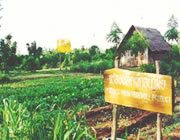
|
Most of the Royal Development Projects concern replenishment and improvement of the natural resources and the environment such as development and conservation of soil, water and forest. The details of the projects can be summarized as follows: |
1. Development and Conservation of Soil
During the past 30 years, increase of production and the farmers’ income arises from expansion of land for cultivation rather than from increase of production per land unit. Until the present, it is estimated that the land suitable for cultivation has almost been used up. The people then seek compensation by migrating and encroaching upon the reserved forests causing the forests to be destroyed in a far greater number. Moreover, the use of land without caution, care and maintenance results in deterioration of the soil with respect to both chemical and physical elements. If not urgently resolved, these problems can impose further adverse effects on the general development of the country.
The implementation of the Royal Development Projects focuses on optimizing the use of the natural resources while restoring the productivity of the deteriorated resources. One example of such projects is the “Soil Aggravation” Project at the Pikun Thong Royal Development Study Centre, Narathiwat Province, about which His Majesty suggested as follows:
“…Conduct an experiment in which the soil is made strongly acidic through drainage. Then study ways to combat the acidity. The results can be used to solve the problems faced by the Narathiwat people in this regard. Tests should be carried out for two years and the crop to be used should be rice…”
“…Flooded lands are useless. If we make them emerge from water, if drainage is provided, enormous use might be made of them by the people in making a living…”
His Majesty’s initiatives in solving the soil problem include that concerning deteriorated soil, soil lacking quality and shortage of land for cultivation which are summarized below:
1.1 encouraging the farmers to be aware of proper techniques in soil and water conservation and improvement which can be easily applicable for the farmers. His Majesty addressed that
“…Improvement of soil should concentrate on conservation of the topsoil which contains rich nutrients. It should not be ploughed or stripped off. The existing perennial trees should be preserved to help maintain the moisture in the soil…”

This results in His Majesty’s initiative of the establishment of the Khao Hin Sorn Royal Development Study Centre. The centre aims to conduct study and research on establishing the soil and water conservation system. It also intends to serve as the model of soil erosion control and to promote propagation of plant species for soil nourishment and conservation. Similarly, the Pikun Thong Royal Development Study Centre has the major objective to conduct study on the peat soil which is high in acidity. There are also demonstration plots where the farmers can observe the techniques for the improvement of different types of soil such as acid soil, saline soil and sandy soil. The purpose is to restore the deteriorated soils back to their productive conditions.
Moreover, on June 22, 1991, His Majesty the King gave for the first time his initiative concerning the vetiver grass to Mr. Sumet Tantivejkul, Secretary-General of the Royal Development Projects Board at that time. His Majesty suggested that the cultivation of the vetiver grass should be experimented for control of soil erosion and maintenance of moisture in the soil since this method is simple, inexpensive and importantly, applicable for the farmers with easy maintenance. His Majesty has continued to give initiatives regarding the various uses of the vetiver grass on 20 additional occasions. For instance, on July 25, 1997, His Majesty graciously delivered a royal speech concerning vetiver grass to the graduates of Kasetsart University as stated in the following excerpt:
“…Vetiver grass must be planted closely to form a living wall on contours suitable to the topography of the area. On highlands, for example, it should be planted as contour hedgerows across the slope and gullies; on the plain, it should be planted on the rims of the plot or along furrows of the ridges, alternating with field crops; in catchment areas, it should be planted on the contour as hedgerows above the area. Vetiver planted according to the above simple methods will prevent erosion of top soil, conserve soil moisture, retain sediments and toxic substances, not permitting them to flow down into water vessels; this will provide considerable benefit to soil and water conservation as well as improve soil and forest rehabilitation..”
However, His Majesty always emphasizes that the whole process of land development should be participated by farmers who can benefit from it.
1.2 promoting land allocation and reform. The deserted land should be developed and allocated to the landless farmers in the form of cooperative village. The farmers are given rights to use the land but not to possess the land. Basic facilities should be provided as appropriate. In addition, land suitable for cultivation should be allocated to the hilltribe people, encouraging them to settle down at a particular location and make a living without having to destroy the forests. In managing this, His Majesty the King relies on the principle that there should be a well-organized plan based on the use of maps and aerial photos right from the beginning. The allocation of land should be managed in the irrigated areas. Concerned with the serious effects of the land problems on the farmers, His Majesty the King initiates the “New Theory” as stated in a royal speech below:
“…The New Theory… is one way to enable the people to have enough food; they won’t be rich but they will have sufficient food and won’t go hungry…”
The “New Theory” is a practice for managing a small piece of land by dividing land into portions and implementing integrated farming. It can be said that the “New Theory” is a set of principles on the proper management of land and water resources to create optimum benefits for farmers and to enable them to become self-supporting. The “New Theory” concept requires dividing the land into four parts which are:
First 30% for rice farming
Second 30 % for field crops and horticulture
Third 30% for pond area for agricultural uses and raising fish
Last 10 % for housing and comprehensive growing of garden crops which enables the farmers to have food for consumption all year round.
2. Development and Conservation of Water Sources
Recognizing that the majority of his subjects are engaged in agriculture and rely on rainwater, His Majesty the King places special attention on development and conservation of water sources which was the driving force behind the establishment of the Huai Hong Khrai Royal Development Study Centre at Doi Saket District, Chiang Mai Province. The Centre aims to conduct research on appropriate patterns of development of watershed areas for economic benefits as well as various development patterns which enable the people to be self-reliant without having to destroy nature. The Centre serves as the model where interested people can obtain knowledge and technology for applying to their occupations while encouraging them to conserve watersheds and develop forests simultaneously. Finally, moisture will occur and the problem of water shortage will be minimized. Relatively, His Majesty initiated the construction of check dams at the Huai Hong Khrai Royal Development Study Centre, as appeared in an excerpt from His Majesty’s statement quoted below:
“…Low-cost weirs should be built, using cheap and locally available materials, for example, gravel in wire mesh, to block a water channel or stream at intervals in order to retain some water and silt. The retained water will seep into the ground, spreading moisture along both sides of the stream. In time, the area will grow capable of sustaining trees that are variously fire retardant, fast-growing, and non-deciduous, so that the watershed area becomes increasingly lush and green…”
His Majesty classified check dam into two categories:
“…There are two types of check dams. One provides and maintains moisture, the other prevents sand from flowing into the main reservoir…”
In other words, the first type is a watershed dam, or moisture-retaining dam. The second type is a silt-collecting dam. In building a check dam, His Majesty added the following details:
“…Check dams that prevent sand from flowing into the main reservoir need to be carefully made and deep enough to be able to collect a large amount of sand. If the water is shallow, the sand flows over into the main reservoir. If the check dam is for retaining moisture, there is no need to dig deep, so long as the dam holds water and lets it percolate into the ground. But the sand-collecting type must be deep and designed in such a way that incoming water does not push away the sand…”
|
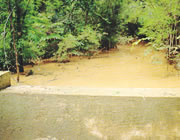
|
His Majesty provided further advice on building check dams to contribute to an optimal hydrologic cycle in the forest:
“…A site should be identified on which to construct a watershed dam as high and close to the hilltop as possible. Such a dam would need another design so that it can hold quite a large volume of water for two months. The ability to reserve water this long after the rainy season ensures adequate water to sustain and nurture, on a regular and continuous basis, the seedlings of hardy and fast-growing trees used for replacement planting in dry forests. This allows water to be distributed around the dams until the seedlings are well established…”
|

3. Development and Conservation of Forest Resources
Forests are the natural resources which contribute both direct and indirect benefits to mankind. Forests regulate the climate, protect watersheds, plant species and wildlife as well as serve as a recreational area. Human beings can make use of forests in various ways: collecting forest products, industry, felling trees for household uses and wood processing. However, rapid increase in the country’s population results in deforestation in an attempt to clear land for cultivation and illegal logging for processing in industry and making charcoal. Moreover, the rush of some projects such as road and dam construction leads to merciless cutting of trees without consideration for the value of conservation of forest resources. Consequently, the forest areas decrease and some parts intensely deteriorate.
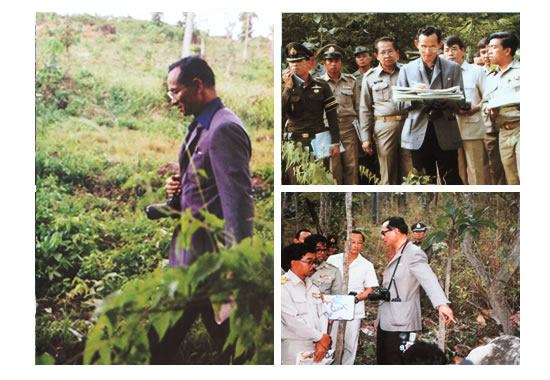
His Majesty the King is aware of the value of forest resources especially in their relation to drought and flooding, which are now facing the nation, caused by forest destruction. His Majesty is determined to rehabilitate, improve and restore the forests to their fertile conditions. Following his initiatives, many projects on forest development and restoration are established throughout the country, especially the one aimimg at maintaining the watershed areas for protection against flooding and absorbing the water to feed rivers and streams. In this regard, His Majesty suggested several theories as follow:
|
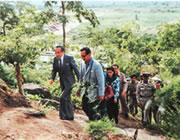
|
Reforestation without Planting: An example of this theory is provided at the Royal-initiated Khao Cha-ngum Deteriorated Soil Rehabilitation Study Project, Ratchaburi Province. The project demonstrates His Majesty’s initiative concerning the rehabilitation of forests based on the principle of natural cycle which is simple and cost-saving as well as supporting the natural cycle of the forest. Under this principle, His Majesty suggests three following methods: |
“…When a suitable location has been found, just leave that forest as it is. Don’t do anything. The area will grow into a full fertile forest by itself without one tree being planted…”
“…Don’t harass the forests or bother the trees. Just protect them, so that they can grow by themselves…”
“…In degraded Shorea forests, nothing needs to be done, because the stumps will sprout new shoots. Although their shape won’t be good, the trees can grow to a good size…”
|
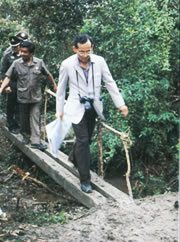
|
3 Forests, 4 Benefits: This theory was implemented at the Huai Sai Royal Development Study Centre, Phetchaburi Province, and the Huai Hong Khrai Royal Development Study Centre, Chiang Mai Province.
“…Now everyone might already understand what three forests are. But one must also understand that three forests provide four benefits. This important fourth benefit is the conservation of soil and watersheds…”
The three forests to be planted should be one part for timber, one for fruits and one for firewood, all of which would yield benefits to the people in a symbiotic manner. Besides, the fourth benefit is the conservation of soil and water.
|
|
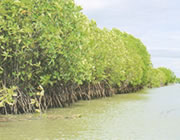
|
Mangrove Forests: This theory demonstrates His Majesty’s initiative regarding conservation and rehabilitation of the ecosystem of coastal areas and the Gulf of Thailand which were encroached upon and devastated. According to this theory, mangrove trees are planted relying on the motion of tides for their growth. The trees form a wall to protect the coastal areas from wind and erosion. Besides, they serve as a habitat for aquatic animals which helps to restore the balance and abundance of the ecological system. |